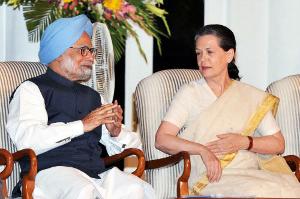 New Delhi, Sep 26: The Congress trumpeted the constitution of seventh pay commission as another of its welfare measures in line with land and food bills, in what appeared a thinly-veiled attempt to milk the olive branch to government employees at the upcoming state and Lok Sabha polls.
New Delhi, Sep 26: The Congress trumpeted the constitution of seventh pay commission as another of its welfare measures in line with land and food bills, in what appeared a thinly-veiled attempt to milk the olive branch to government employees at the upcoming state and Lok Sabha polls.
The surprise decision on the pay commission targetting middle-classes comes on the back of legislations to win over the poor and the sudden urgency in Congress establishment to facilitate new alliances: clear evidence that the ruling party has hit poll mode.
The belief is that tough reforms are over for good in UPA-2 and the ruling camp would try the time-tested sops to win electoral favour.
Not surprisingly, Congress patted the leadership for bringing the pay panel just ahead of festivals while slamming NDA for not doing so in 2003 when the sixth commission was due. "It has brought happiness to lakhs of people," AICC spokesman Raj Babbar said, adding it would benefit 80 lakh people.
With the Centre having rushed to pass the land and food bills as 'aam aadmi' sops earlier, the Centre has now picked on middle classes -- the pay panel coinciding with assurance from petroleum minister Veerappa Moily that there would be no hike in petrol prices.
The importance of the new step in bolstering urban constituencies is evident from how AICC general secretary Ajay Maken first made the demand for pay panel in a letter to Prime Minister Manmohan Singh this March. His New Delhi constituency, populated by government servants, is especially susceptible to such overtures.
Besides the electorate, rural and urban, Congress has moved with alacrity to woo regional satraps -- the Cabinet on Tuesday passed an ordinance to save convicted MPs from disqualification, aimed at appeasing Lalu Prasad who faces a final verdict in the infamous fodder scam on September 30.
The Centre's hidden hand is seen in the sudden softening of enforcement agencies facilitating the bail for YSR Congress chief Jaganmohan Reddy: an olive branch to the rebellious Reddy.
Many believe that Bihar may also get the tag of "backward state" ahead of polls that would open up the Congress option with JD(U) in the crucial state.
The urgency in Congress ranks appears to stem from the realisation that 2014 as well as end-year assembly polls would be a tough test. The decision on pay panel seems an acknowledgment that Delhi polls may be a challenge this time.
Observers say that central pay panel also has an effect on state employees since it brings pressure on the states governments to follow suit. The public employees and teachers are believed to play a big role in influencing the opinion of voters.





Comments
Add new comment